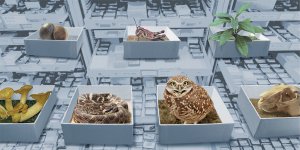Presented By: Ecology and Evolutionary Biology
Early Career Scientists Symposium: Natural History Collections: Drivers of Innovation
Keynote presentation: Pamela Soltis, Distinguished Professor and Curator, Florida Museum of Natural History, University of Florida, Integrative research using natural history collections: examples from herbaria

A virtual symposium held on five consecutive Fridays beginning March 5, 2021.
REGISTRATION required for Zoom entry. Registrants will receive the Zoom link and passcode via email. See links this page to register and for more information.
Session V (Moderator: Brad Ruhfel)
1 pm Welcome and introduction: Brad Ruhfel
1:05 pm Closing remarks: Hernán López-Fernández
1:15 pm Keynote presentation: Pamela Soltis
2 pm Panel discussion: Pamela Soltis, Hernán López-Fernández
Abstract
Emerging cyberinfrastructure and new data sources provide unparalleled opportunities for mobilizing and integrating massive amounts of information from organismal biology, ecology, genetics, climatology and other disciplines. Key among these data sources is the rapidly growing volume of digitized specimen records from natural history collections. The world’s herbaria house an estimated 400,000,000 specimens, and as the number of online records – currently at ~60,000,000 – continues to grow, these data provide excellent information on species distributions, changes in distributions over time, phenology and a host of traits. Integration of information from specimen records with phylogenies, climate data and other resources enables new questions to be addressed while also providing new perspectives on longstanding questions in ecology and evolutionary biology. Although challenges to linking heterogeneous data remain, new advances are enabling the use of herbarium and other museum data in novel ways. Through a series of case studies, I will illustrate some of the many uses to which herbarium specimen data are currently being applied as well as some of the resources being developed to enable their use. These case studies link and analyze specimen data and related heterogeneous data sources to address a range of evolutionary and ecological problems.
Read more, including about the speakers and their talks, on the ECSS website: https://sites.lsa.umich.edu/ecss/
REGISTER: https://sites.lsa.umich.edu/ecss/home/register/
Illustration: John Megahan. Image credits: Eric LoPresti, John Megahan, Timothy James, Linda Garcia
REGISTRATION required for Zoom entry. Registrants will receive the Zoom link and passcode via email. See links this page to register and for more information.
Session V (Moderator: Brad Ruhfel)
1 pm Welcome and introduction: Brad Ruhfel
1:05 pm Closing remarks: Hernán López-Fernández
1:15 pm Keynote presentation: Pamela Soltis
2 pm Panel discussion: Pamela Soltis, Hernán López-Fernández
Abstract
Emerging cyberinfrastructure and new data sources provide unparalleled opportunities for mobilizing and integrating massive amounts of information from organismal biology, ecology, genetics, climatology and other disciplines. Key among these data sources is the rapidly growing volume of digitized specimen records from natural history collections. The world’s herbaria house an estimated 400,000,000 specimens, and as the number of online records – currently at ~60,000,000 – continues to grow, these data provide excellent information on species distributions, changes in distributions over time, phenology and a host of traits. Integration of information from specimen records with phylogenies, climate data and other resources enables new questions to be addressed while also providing new perspectives on longstanding questions in ecology and evolutionary biology. Although challenges to linking heterogeneous data remain, new advances are enabling the use of herbarium and other museum data in novel ways. Through a series of case studies, I will illustrate some of the many uses to which herbarium specimen data are currently being applied as well as some of the resources being developed to enable their use. These case studies link and analyze specimen data and related heterogeneous data sources to address a range of evolutionary and ecological problems.
Read more, including about the speakers and their talks, on the ECSS website: https://sites.lsa.umich.edu/ecss/
REGISTER: https://sites.lsa.umich.edu/ecss/home/register/
Illustration: John Megahan. Image credits: Eric LoPresti, John Megahan, Timothy James, Linda Garcia

Related Links
Co-Sponsored By
- Matthaei Botanical Gardens & Nichols Arboretum
- Kelsey Museum of Archaeology
- Earth and Environmental Sciences
- Museum of Natural History
- School for Environment and Sustainability
- Museum Paleontology
- Museum of Anthropological Archaeology
- University of Michigan Biological Station
- Program in Biology
- Research Museums Center